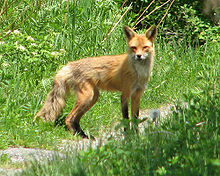American red fox
| (Eastern) American red fox | |
|---|---|
 |
|
| Scientific classification | |
| Kingdom: | Animalia |
| Phylum: | Chordata |
| Class: | Mammalia |
| Order: | Carnivora |
| Family: | Canidae |
| Genus: | Vulpes |
| Species: | V. vulpes |
| Subspecies: | V. v. fulvus |
| Trinomial name | |
|
Vulpes vulpes fulvus Desmarest, 1820 |
|
| Synonyms | |
|
V. v. pennsylvanicus Rhoads, 1894 |
|
V. v. pennsylvanicus Rhoads, 1894
The American red fox (Vulpes vulpes fulvus), commonly known as the eastern American red fox is a North American subspecies of the red fox (Vulpes vulpes). Historically, red foxes were classified as two species: Vulpes vulpes in Eurasia and Vulpes fulva in the Americas (Tesky, 1995). Since 1959 they have been considered to be a singular species of Vulpes vulpes, with Vulpes fulva one of the ten subspecies (Hall, 1981; Kamler & Ballard, 2002). The American red fox differs from European forms by the greater breadth of its feet, its longer fur, noticeably shorter nose and ears, and its finer brush. According to hunters' accounts, they have less vigor and endurance in the chase compared to the European variant.
Vulpes vulpes fulva inhabits the entire region of the United States east of the Rocky Mountains except for Florida, the southern Great Plains, and southern Texas (Frey, 2013; Tesky, 1995). The American red fox generally prefers mixed vegetation communities that occur on edge habitats with a high level of diversity (Tesky, 1995). In developed areas the American red fox will inhabit areas that offer a combination of woodland and agricultural land (Tesky, 1995).
The eastern American red fox has a primarily carnivorous diet dominated by small mammals (Frey, 2013). However, as an opportunistic species they will adopt an omnivorous diet that includes insects, fruits, berries, birds, plants, and other small animals (Tesky, 1995). Food sources can vary depending on region, but cottontails rabbits (Sylvilagus) are the most important prey for eastern American red foxes (Frey, 2013). The eastern American red fox will consume larger animals as carrion, and their diet changes depending on seasonal variability (Tesky, 1995).
Current literature discusses whether or not the red fox is native to North America, with some research suggesting that nearly all fox populations in North America are not native (Kamler & Ballard, 2002). Vulpes vulpes fulva is usually seen either as an exotic species introduced by Europeans during the colonization of the North American continent or as a hybrid between Eurasian and native foxes (Frey, 2013; Aubry et al., 2009). While it is claimed that Vulpes vulpes fulva stems from a nonnative population that spread westward from European introduction (Kamler & Ballard, 2002), a historical analysis of firsthand accounts does not support this claim (Frey, 2013).
Phylogeographical and genetic analysis of the North American red fox suggests that foxes first migrated to North America during the Illinoian glaciation (300,000 to 130,000 years before present) and spread southward (Aubry et al., 2009) More recently the Wisconsin glaciation (100,000 to 10,000 before present) separated the North American fox population into two distinct areas (Aubry et al., 2009). American red foxes are genetically distinctive from their Eurasian counterparts (Aubry et al., 2009; Frey 2013). Despite claims of historical translocations from Europe, modern red fox populations in the United States’ southeastern region have been shown to be native to North America (Statham et al., 2012). DNA comparisons show that the eastern American red fox is closely related to native populations in Canada and the northeastern region of the United States and is therefore the result of natural range expansions and not an invasive species from Europe as was previously thought (Statham et al., 2012). Range expansions seen recently may be connected to anthropogenic landscape change and not the spread of exotic European varieties (Statham et al., 2012).
...
Wikipedia
